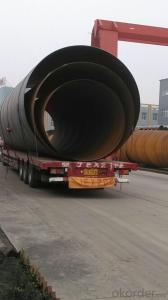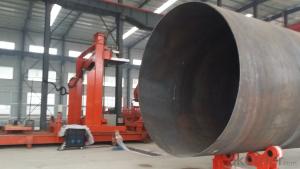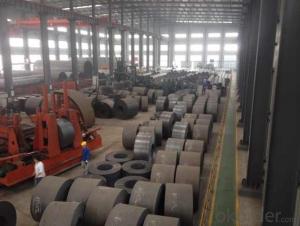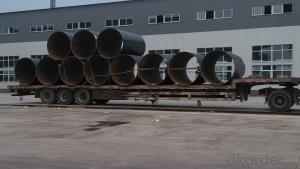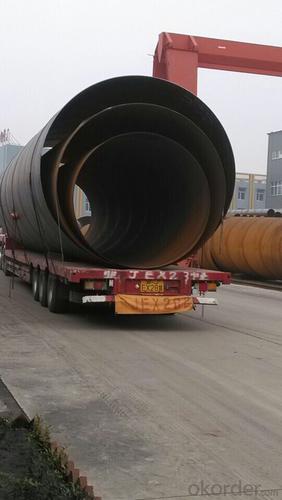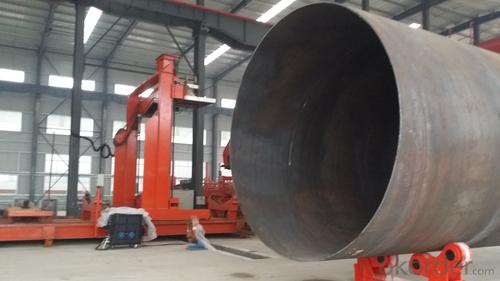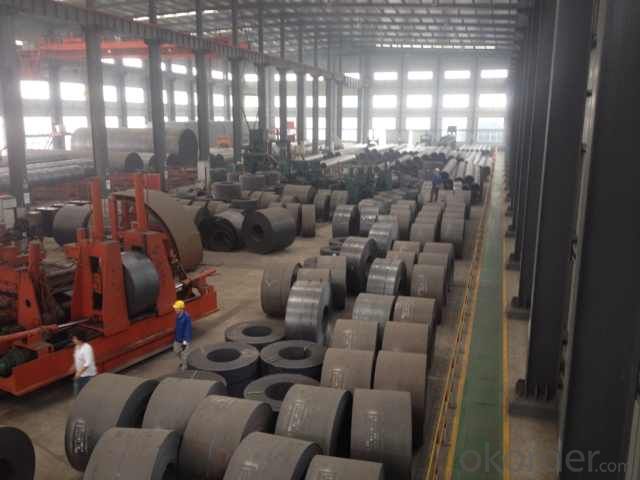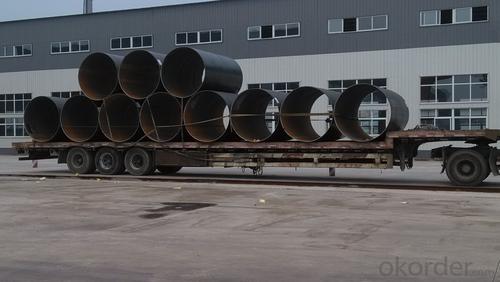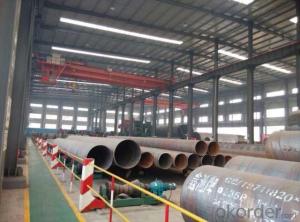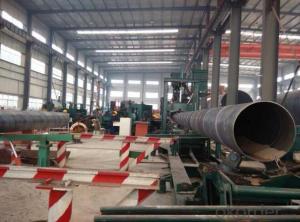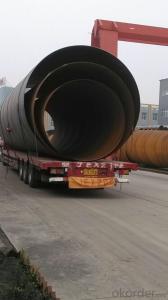SSAW STEEL PIPE 219-3920MM API/ISO/ASTM/JIS
- Loading Port:
- China Main Port
- Payment Terms:
- TT OR LC
- Min Order Qty:
- -
- Supply Capability:
- -
OKorder Service Pledge
OKorder Financial Service
You Might Also Like
Packaging & Delivery
Packaging Detail: | standard export packing or as customer's requirement |
Delivery Detail: | within 10 - 30 days |
Specifications
Spiral Welded Steel Pipes and Tubes
1.Material:Q195-Q235
2.Length:1-12m
3.WT:1.0-14mm
4.O.D.:219-3920mm
Product Description:
1.Material : Q235,Q345,L245,L290,L360,L415,L450,L485,GrB,X42,46,X52,X56,X60,X65,X70,X80,X100
2,Standard: SY/T5037-2000,GB/T9711-2011,API Spec 5L PSL1/PSL2,ASTM A252\A53,ISO3183,DIN17172,EN10217,JIS G3457,AWWA C200,ASTM A139,ASTM A671,ASTM A672
3.Wall thickness: 3.0mm-30mm
4.Outer diameter: φ219mm-3920mm
5,Length: 5m-12m or as customer requirement
6,Corrosion protection standard: DIN30670,DIN30671, AWWAC210, AWWA C203, SY/T0413-2002,SY/T0414-2002
7,Application: Oil, gas, natural gas, water pipe, thermal electricity pipe, steel structure engineering, etc
Q195-Q345 Material Steel Pipe's Materials
Elements | Chemical Compsition% | Mechanical Property | ||||||
| C% | Mn% | S% | P% | Si% | Yield Point (Mpa) | Tensile Strength(Mpa) | Elongation |
Q195 | 0.06-0.12 | 0.25-0.50 | <0.050 | <0.045 | <0.030 | >195 | 315-430 | 32-33 |
Q215 | 0.09-0.15 | 0.25-0.55 | <0.05 | <0.045 | <0.030 | >215 | 335-450 | 26-31 |
Q235 | 0.12-0.20 | 0.30-0.70 | <0.045 | <0.045 | <0.030 | >235 | 375-500 | 24-26 |
Q345 | <0.20 | 1.0-1.6 | <0.040 | <0.040 | <0.55 | >345 | 470-630 | 21-22 |
- Q: Are steel pipes suitable for underground industrial waste disposal?
- Due to their durability and strength, steel pipes find frequent use in underground industrial waste disposal. Their ability to withstand harsh underground conditions, such as moisture, pressure, and corrosion, is noteworthy. Furthermore, steel pipes exhibit resistance to chemical reactions, making them well-suited for managing diverse types of industrial waste. In this manner, they can effectively transport and confine hazardous materials, thereby guaranteeing the safety and safeguarding of the environment and its surroundings. Overall, steel pipes are widely acknowledged as a dependable and effective choice for underground industrial waste disposal.
- Q: Seamless steel pipe is how to do it?
- Round tube has some limitations, such as in the plane bending conditions, the tube is better than square and rectangular tube bending strength, and some agricultural machinery skeleton, steel, wood furniture, commonly used square, rectangular tube. According to different purposes, other sections of special-shaped steel pipe are needed.
- Q: Outside diameter 60, thickness 3.5 seamless steel tube, how many kilograms per meter?
- Steel tube Kg/m (including seamless steel tubes and welded tubes) theoretical formula per meter weight: W=0.02466 * S * (D-S)Of which: S - wall thickness (mm), D - steel tube diameter (mm), W - kg / M
- Q: How are steel pipes used in the manufacturing of marine applications?
- Steel pipes are commonly used in the manufacturing of marine applications due to their durability and resistance to corrosion. They are used for various purposes such as constructing ship hulls, offshore platforms, and underwater pipelines. These pipes provide structural support and can withstand the harsh conditions of the marine environment, making them essential components in the manufacturing process of marine applications.
- Q: How do you calculate the stress in a steel pipe?
- When calculating the stress in a steel pipe, it is necessary to take into account the steel's material properties and the external forces acting upon the pipe. The stress in the pipe is typically determined using the following equation: Stress = Force / Area Initially, the force acting on the pipe must be established. This force may stem from external loads such as pressure, weight, or mechanical forces. The force can be calculated by multiplying the pressure or weight by the surface area it acts upon. For instance, if the pipe is subjected to internal pressure, the force can be determined using the equation: Force = Pressure x Area Subsequently, the cross-sectional area of the pipe needs to be determined. The cross-sectional area of a circular pipe can be calculated using the formula: Area = π x (Diameter / 2)^2 Once the force and area have been determined, the stress can be calculated by dividing the force by the area. This calculation will yield the stress value in units like pounds per square inch (psi) or newtons per square meter (Pa). It is important to bear in mind that the stress calculation assumes that the pipe is in a state of equilibrium and that the material properties of the steel are known. The material properties, such as yield strength and ultimate tensile strength, are utilized to ensure that the calculated stress does not exceed the steel's maximum capacity.
- Q: How are steel pipes used in underground drainage systems?
- Steel pipes are commonly used in underground drainage systems due to their durability and strength. They are typically used to carry and transport wastewater and stormwater away from buildings and structures to a designated disposal area or treatment facility. The corrosion-resistant nature of steel pipes ensures a long lifespan, making them a reliable choice for underground drainage applications. Additionally, steel pipes can withstand high water pressure and are often used in larger diameter pipes to handle a higher volume of water flow.
- Q: What are the safety measures to consider when working with steel pipes?
- When working with steel pipes, it is important to follow specific safety measures to ensure a safe working environment. Some key safety measures to consider include wearing appropriate personal protective equipment (PPE) such as gloves, safety glasses, and steel-toed boots to protect against potential injuries. Additionally, workers should be cautious of sharp edges and use tools designed for cutting and handling steel pipes. It is crucial to secure pipes properly to prevent accidents caused by falling or rolling pipes. Lastly, workers should be trained on proper lifting techniques to avoid strain or injury when handling heavy steel pipes.
- Q: How are steel pipes cleaned and flushed?
- Steel pipes can be cleaned and flushed using various methods depending on the specific requirements and conditions. One common method is mechanical cleaning, which involves the use of wire brushes, scrapers, or other abrasive tools to physically remove any debris, rust, or scale from the inner surface of the pipes. This method is effective for removing loose or easily detachable contaminants. Chemical cleaning is another widely used method, especially for pipes with more stubborn deposits or rust. Various chemicals or cleaning agents are flushed through the pipes to dissolve or loosen the buildup, which can then be washed away. Acid-based solutions are commonly used for this purpose, but it is important to choose the appropriate chemical and concentration to avoid damaging the pipes. High-pressure water jetting is another effective method for cleaning and flushing steel pipes. Water is pumped at high pressure through a nozzle, creating a powerful jet that can dislodge and remove any debris or deposits from the pipe walls. This method is particularly useful for removing hard or compacted materials that cannot be easily removed by other means. In some cases, a combination of these methods may be required to achieve the desired cleanliness. For instance, a pre-cleaning with mechanical tools can be followed by chemical cleaning or high-pressure water jetting to ensure thorough flushing and removal of contaminants. Regular maintenance and cleaning of steel pipes are essential to maintain their efficiency and prevent corrosion. It is important to follow proper procedures and safety guidelines when cleaning and flushing steel pipes to ensure effective results and avoid any damage to the pipes.
- Q: How are steel pipes used in the construction of oil and gas pipelines?
- Steel pipes are commonly used in the construction of oil and gas pipelines due to their high strength, durability, and resistance to corrosion. These pipes are employed to transport crude oil and natural gas from extraction sites to refineries and distribution centers. They provide a reliable and efficient means of transporting these valuable resources over long distances, ensuring a safe and secure supply of energy. Additionally, steel pipes are capable of withstanding high pressure and extreme temperature conditions, making them suitable for the demanding environment of oil and gas transportation.
- Q: What are the different types of steel pipe elbows?
- There are several different types of steel pipe elbows that are commonly used in various industries and applications. These types include: 1. 90-degree elbows: These elbows have a sharp 90-degree bend and are commonly used when a change in direction is required to redirect the flow of fluid or gas. They are widely used in plumbing, construction, and industrial piping systems. 2. 45-degree elbows: Similar to 90-degree elbows, 45-degree elbows also provide a change in direction but with a smaller angle. They are often used in situations where a more gradual change in flow direction is required. 3. Long radius elbows: Long radius elbows have a larger radius of curvature compared to standard elbows. This design helps to reduce fluid friction and pressure drop, making them suitable for applications that require smoother flow, such as in high-flow systems or those involving viscous fluids. 4. Short radius elbows: In contrast to long radius elbows, short radius elbows have a smaller radius of curvature. They are generally used in tight spaces where a compact design is required, but they can cause higher pressure drops due to increased fluid friction. 5. Reducing elbows: These elbows are used when there is a need to connect pipes of different diameters. They have one end with a larger diameter and the other end with a smaller diameter, allowing for a smooth transition between two pipes of different sizes. 6. Mitered elbows: Mitered elbows are custom-made elbows that are fabricated by cutting and welding multiple sections of pipe at specific angles. They are often used in situations where standard elbows cannot accommodate the required angle or when a unique design is needed. Overall, the selection of the appropriate type of steel pipe elbow depends on factors such as the application, fluid flow requirements, space constraints, and compatibility with the piping system.
Send your message to us
SSAW STEEL PIPE 219-3920MM API/ISO/ASTM/JIS
- Loading Port:
- China Main Port
- Payment Terms:
- TT OR LC
- Min Order Qty:
- -
- Supply Capability:
- -
OKorder Service Pledge
OKorder Financial Service
Similar products
Hot products
Hot Searches
Related keywords
